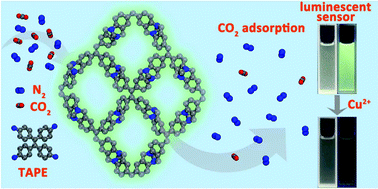Multifunctional porous Tröger's base polymers with tetraphenylethene units: CO2 adsorption, luminescence and sensing properties†
Abstract
Luminescent porous organic polymers have shown potential applications in sensing, light-harvesting, photocatalysis and photo-voltaic or electronic devices. In this paper, a luminescent porous Tröger's base polymer (LMOP-15) with a tetraphenylethene unit has been synthesized by a simple method through the reaction of 1,1,2,2-tetrakis(4-aminophenyl)ethene and dimethoxymethane in acid solution at room temperature. The N2 adsorption of LMOP-15 at 77 K reveals the type I isotherm of microporous materials, and the calculated Brunauer–Emmett–Teller surface area is 484 m2 g−1. The CO2 uptake capacity of LMOP-15 at 273 K and 1 bar is 48.8 cm3 g−1, while the isosteric heat for CO2 reaches 53.7 kJ mol−1 due to the presence of the Tröger's base moiety. The CO2/N2 adsorption selectivity calculated from the initial slopes of the CO2 and N2 adsorption isotherms at 273 K is up to 61.7. LMOP-15 also exhibits strong green luminescence (λmax = 517 nm) in ethanol suspension. Furthermore, LMOP-15 shows highly selective fluorescence quenching detection abilities for Cu2+ ions and picric acid.



 Please wait while we load your content...
Please wait while we load your content...